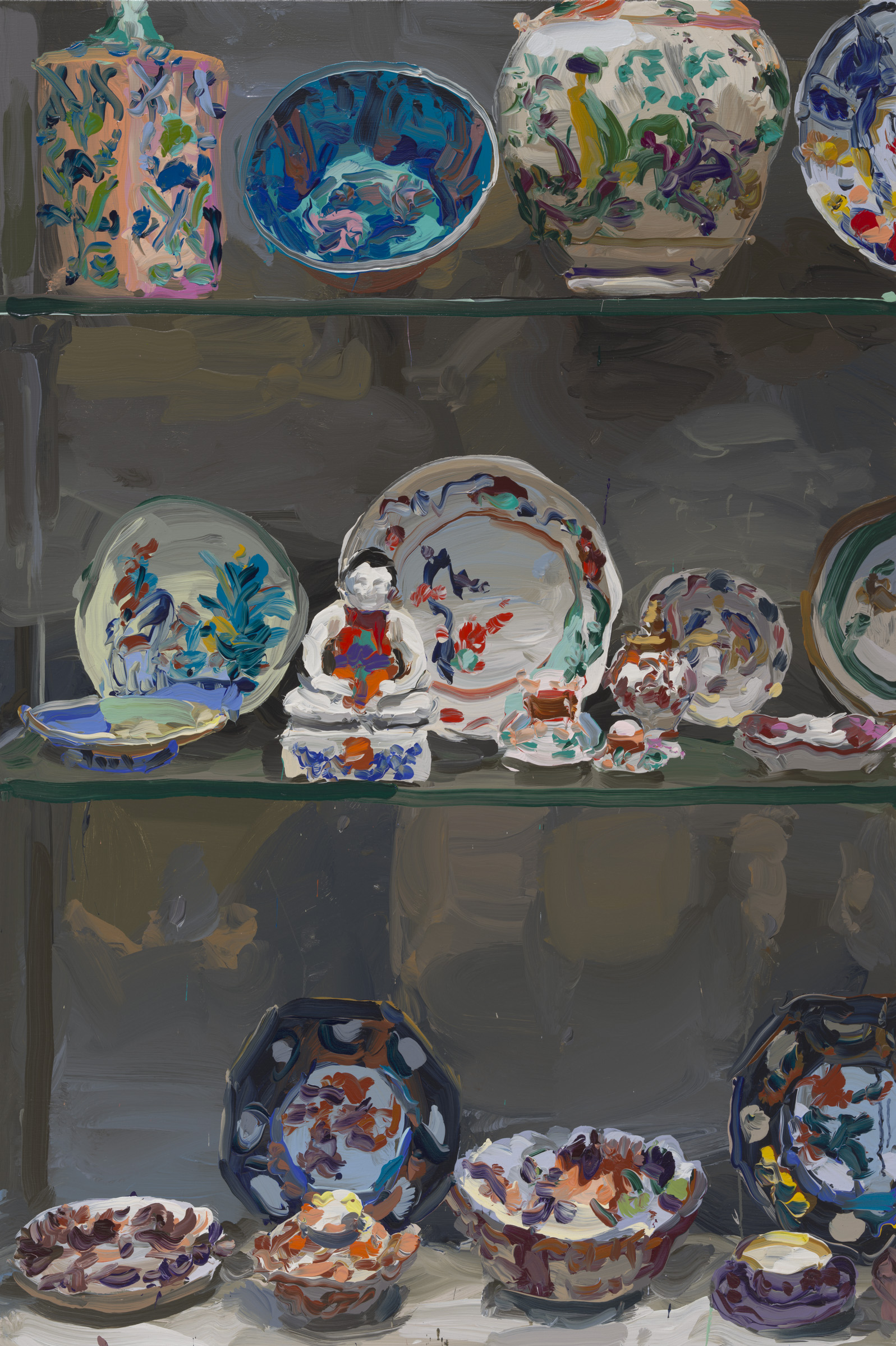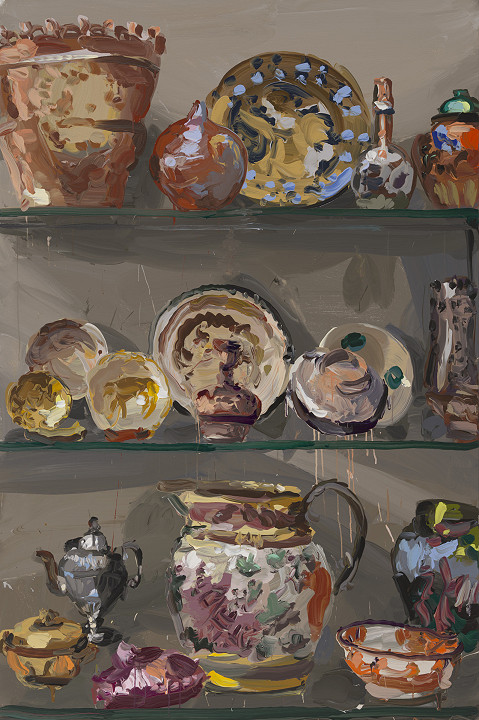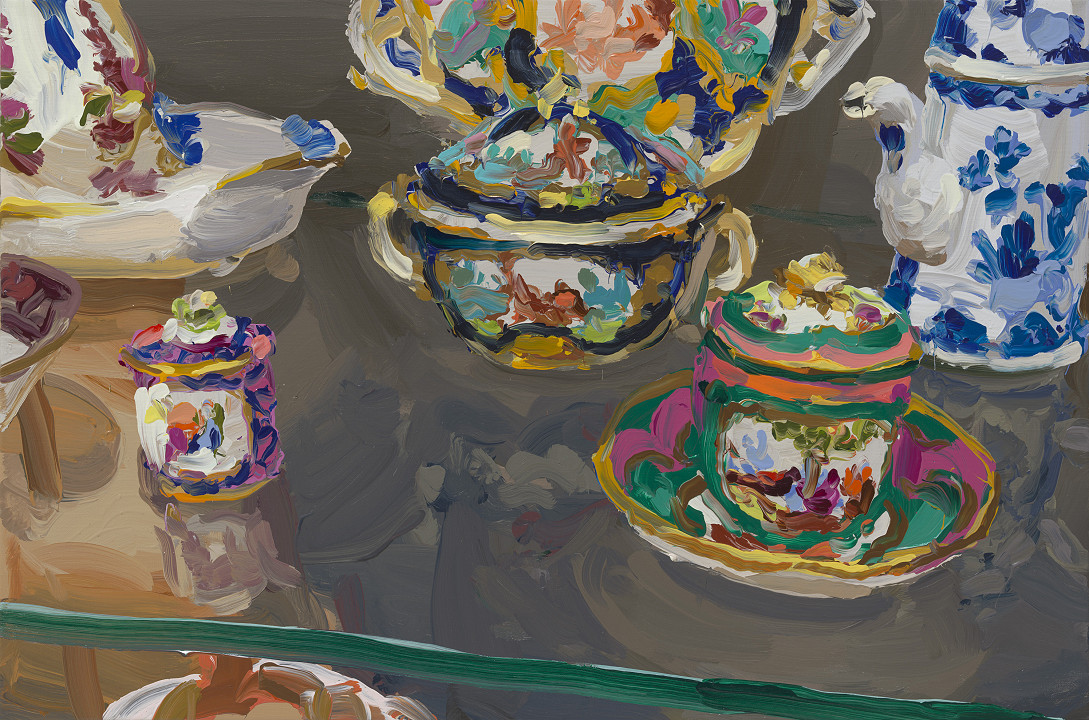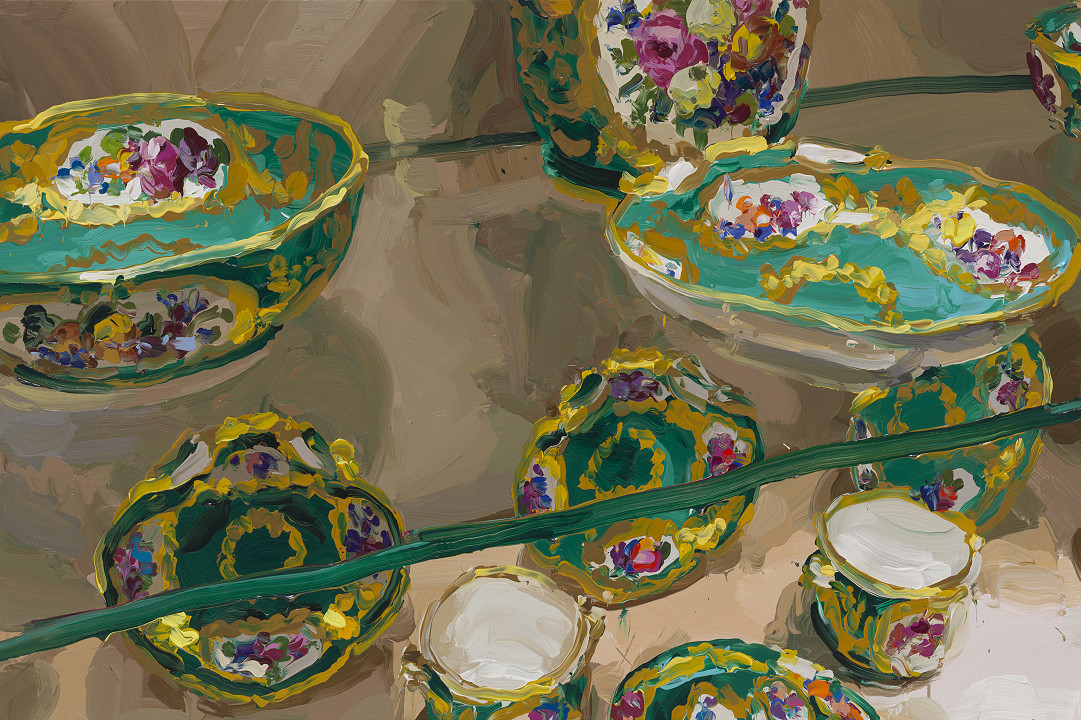Jan De Vliegher
Treasury — part 2
04.09.2022 - 15.10.2022
Opening: Sunday 4 September 14-19h
Jan De Vliegher presents a new series of idiosyncratic still lifes in the exhibition "Treasury part 2" at Galerie Zwart Huis. In 2011, De Vliegher exhibited his richly filled cabinets with porcelain tableware for the first time at the gallery and the Castle of Gaasbeek. He found inspiration for this series of paintings in the Victoria & Albert Museum in London. The baroque cabinets appear as abstract still lifes, where reality becomes richer and freer. Through the hands of the artist the object becomes a new creation, an abstract idea, a desire that reaches beyond the function of the ornament.
Jan De Vliegher’s (°1964 – lives and works in Bruges) canvases act as an encounter of abstract movements and figurative perspectives, expressionist brushstrokes and impressionist accents, and, above all, of a ‘joie de vivre’ and a ‘joie de peindre’. Since his debut in 1998 De Vliegher has worked on several series based on careful observations of everyday life. He finds beauty in what’s small, like objects found on the beach, in the garden or in shop windows, but also in the luxury of palaces, churches and castles. He paints in a fast and baroque manner, ‘alla prima’, and often large-scale. But his art mainly revolves around the act of painting itself. In De Vliegher's work, colour, light, composition and perspective play an essential role. The proposed subject matter is of secondary importance to him, because it is nothing more than an opportunity to paint, a means of producing images. It is merely the painterly presence of the visualisation that seems to fascinate him – not as a superficial decorative piece of art, but also not as a conceptual representation, a profound development of vision, nor as a social or societal signal. De Vliegher registers visual stimuli and puts them in a pictorial space. He reduces the world to an image, until the image becomes a world in itself. What happens isn’t complicated, but miraculous.
De Vliegher paints quickly and accurately. He tries to apply paint to the canvas in one go. He paints ‘alla prima’ or wet-on-wet, a technique where paint is added to layers of still-wet, already-applied paint. The underlying layers of paint do not have to be dry before new layers are mixed with or applied over them, and the blending of colours happens on the canvas itself, not on a palette. He continues to push the physical qualities of paint to their limits by spreading the tactile elements accurately all over each canvas. The promptness of painting is paramount here. It is the hand that follows the eye, and not the other way around. He paints loosely and widely from his shoulders – a liberating technique that allows for a more dynamic flow than working from the wrist would. Moreover, this technique manages to lay the inspiration and energy of the moment onto the canvas very quickly and in one single movement.
While painting De Vliegher cuts himself off from the outside world for a few hours and executes his images by using virtuoso brushstrokes. A direct touch, a wide brush stroke or a short push of the brush turn the formation of an image into a whole. He knows exactly how to create light or dark accents, or how to generate a specific tactile suggestion of material. Creamy paint drips onto flax cloth, paint runs, and wet paint piles up in certain areas, revealing all and any cracks or splatters. These small irregularities expose the basic elements of painting, and move sensually between the pure representation and a personal handwriting that looks as if it’s nonchalant and unfinished. De Vliegher’s talent for painting is assembled with experience, research, drive, and reflection. As a result, he is aware of classical painting techniques to such an extent that he can avoid, manipulate, and deny them. De Vliegher strives for a radical relaxation of the image, and allows the pictorial fashion of expression to transcend the content. Inherent to the art of painting, it revolves around the definition of the image. Through paint and brushwork, he develops a contemporary oeuvre with a personal panache. His enthusiasm and intuition stand in the spotlight.
In this sphere of freedom and abundance, however, all works are harmoniously composed through often monumental formats, in which the experience of space seems to stand by itself. Like an architect or a builder, De Vliegher constructs each of his works according to a certain ratio and harmony, be it in a grid or autonomously. Every work’s foundation is based on a sense of balance, order, or location. He usually works with ‘all-over compositions’, referring to Henri Matisse who thought that positive and negative spaces should always be balanced. In series like the ones with porcelain plates or with chandeliers, negative spaces are structures that are scattered all over the surface. In other series these spaces are mainly repetitive exercises, the grid of which he can experiment in. This is the case with, for example, the display cases with ceramics. De Vliegher has shifted from the purely abstract work of his early period to a freer kind of figuration. In essence, the abstract and the realistic paintings deal with the same issues. His work continues to be about the painter’s affinity with the art of painting, his love for colour, and the poetry of painting.
By painting the same subjects over and over, and by turning them into series, he wants to capture observable reality in the form of a painterly reality that is subject to constant change.His preference for series is essentially a process of getting rid of that reality: the painter’s desire is veiled by the various variations on a theme. As with Edgard Degas, Paul Cezanne or Giorgio Morandi, the realistic illusion comes to a halt and the subject turns into paint, by painting it again and again, and by trying to grasp time. His themes range from landscapes, gardens, beach scenes, terraces in bird’s eye view, and reflections in water, to architectural elements and display cabinets, lavish interiors and chandeliers, busts, plates and glasses.
His enthusiasm for painting has not died down in the past 25 years. In 20202 De Vliegher is still warm and jovial, an impersonator of cheerfulness, with which the joy of painting is translated onto his canvases. It is an infectious oeuvre that joyfully combines the idea of ‘hakuna matata’ with the seriousness of the profession, and that is a top sport performance while painting. Moreover, that healthy dose of euphoria is a resilient vessel full of surplus stock, which conjures light and helps to protect against setbacks. It’s not frivolousness, but lightness.
(Extract from ‘Myriad Pursuits’, Els Wuyts, 2021)








